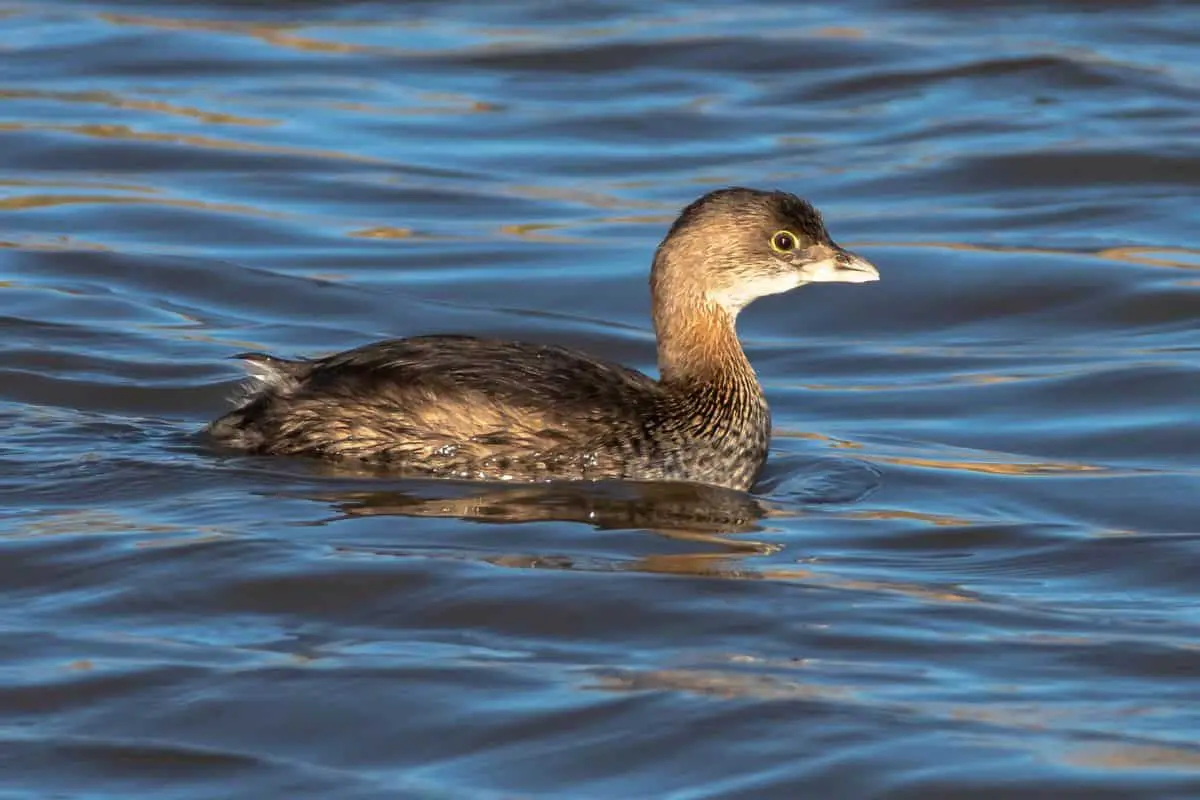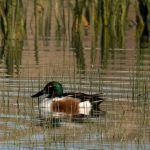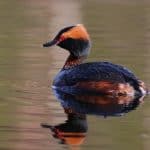The Pied-billed Grebe, also known as the water grebe, is a small, brown waterbird found across much of North America. These expert divers inhabit freshwater marshes, lakes, estuaries, and sluggish rivers, using their thick bills to kill and eat crustaceans, fish, amphibians, insects, and other aquatic creatures.
While the species is not on the endangered species list and is considered of least concern, it has experienced declines in recent decades. Interestingly, the Pied-billed Grebe has also been spotted in Hawaii, where it is considered a rare vagrant. Despite its elusive nature, the Pied-billed Grebe is a fascinating bird that is worth learning more about.
Pied-billed Grebe
Appearance
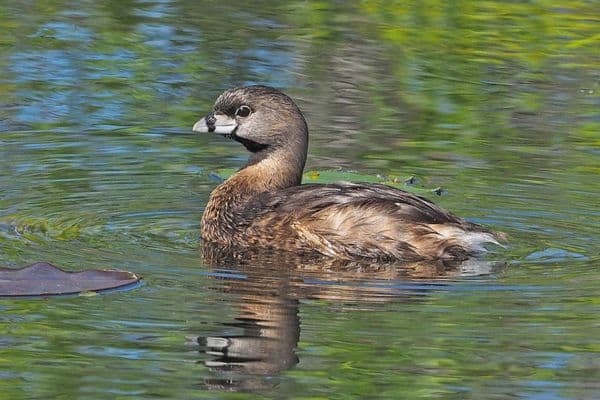
The Pied-billed Grebe is a small waterbird with a stocky body and a short neck. On average, it measures between 12 to 15 inches in length and weighs between 8.9 to 20 ounces.
The bird’s wingspan typically ranges from 18 to 24 inches. The Pied-billed Grebe’s plumage is primarily brown, with a darker back and crown. The bird’s most distinctive feature is its unusually thick bill, which turns silver and black during the summer months.
Diet
The diet of the Pied-billed Grebe is highly variable and depends on its location and the season. These birds are opportunistic feeders and will eat a wide variety of aquatic creatures in their habitat, including insects, fish, crustaceans, and amphibians.
Some of their major food items include aquatic insects, small fish, and crayfish. The Pied-billed Grebe is known for its ability to dive and swim underwater for extended periods of time, allowing it to hunt for prey effectively.
Nesting
The nesting behavior of the Pied-billed Grebe is unique and well-adapted to its aquatic habitat. These birds typically build their nests in shallow water in marshes, ponds, and other wetland areas.
The nest is usually constructed from a dense mass of plant material and is often anchored to the bottom or floating on the surface. Both male and female Pied-billed Grebes contribute to the construction of the nest.
The birds will often build their nests near an opening in the vegetation, allowing them to approach the nest underwater. After the eggs are laid, both parents take turns incubating them until they hatch.
The chicks are born precocial and can swim and dive immediately after hatching. However, the parents continue to protect and care for the chicks for several weeks, often carrying them on their backs.
Behavior
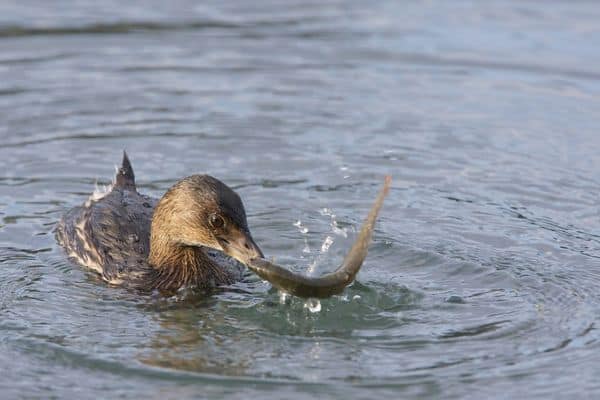
The behavior of the Pied-billed Grebe is fascinating and well-suited to its aquatic environment. These birds are excellent swimmers and divers, using their wings and feet to propel themselves through the water.
They are also skilled at catching prey underwater, using their thick bills to grab and kill fish, crustaceans, and other aquatic creatures. Pied-billed Grebes are generally solitary birds, although they may form loose groups during migration or in winter.
When threatened, they will often dive underwater and swim away from danger. During the breeding season, Pied-billed Grebes become more territorial and may engage in aggressive displays to defend their nests.
Habitat
This bird species is well-adapted to a variety of aquatic habitats. These birds can be found in freshwater marshes, lakes, ponds, and slow-moving rivers across much of North and South America.
During the winter months, they may also be found in salt bays and other coastal areas. The Pied-billed Grebe prefers habitats with dense vegetation and some open water, allowing it to hide from predators and approach prey underwater. The species is highly adaptable and can thrive in both natural and man-made wetland habitats.
Range
Pied-billed Grebes are not known to breed in Hawaii, but individuals have been reported on several of the islands, including Oahu, Kauai, and Hawaii Island. However, they are considered rare vagrants to the islands, meaning that they are not regular residents and may only occasionally be spotted there.
Conservation Status
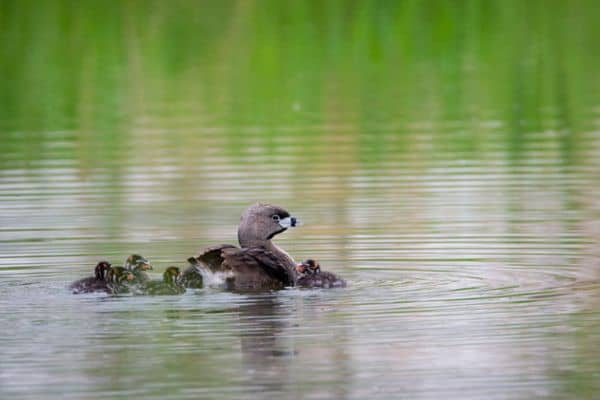
The conservation status of the Pied-billed Grebe in Hawaii is not well-documented, as the species is considered a rare vagrant to the islands. However, the species is still common and widespread across much of North and South America, although surveys have shown declines in recent decades.
The Pied-billed Grebe is currently listed as a species of least concern by the International Union for Conservation of Nature (IUCN) due to its large range and stable population. Nonetheless, the species still faces threats such as habitat loss and degradation, pollution, and disturbance from human activities. It is important to continue monitoring the population of Pied-billed Grebes in Hawaii and elsewhere to ensure the long-term survival of the species.
Interesting Facts
1. Excellent swimmers and divers
They are excellent swimmers and divers, using their wings and feet to propel themselves through the water.
2. Generally solitary birds
Pied-billed Grebes are generally solitary birds, although they may form loose groups during migration or in winter.
3. They occasionally eat their feathers
Pied-billed Grebes are known to occasionally eat their own feathers, which may help to protect their digestive system from sharp fish bones and other indigestible materials.
4. Distinctive call
Pied-billed Grebes have a distinctive call that sounds like a low, rolling laugh. They may also make a variety of other sounds, including grunts, hisses, and whistles.
5. A monogamous bird
They are monogamous and typically mate for life, although they may form new pairs if a mate dies.
6. Referred to as the “devil-diver”
The species is sometimes referred to as the “devil-diver” due to its ability to dive and swim underwater for extended periods of time.
Frequently Asked Questions
1. What is the lifespan of a Pied-billed Grebe?
The lifespan of a Pied-billed Grebe is typically around 3-4 years in the wild, although some individuals have been known to live up to 9 years.
2. Do Pied-billed Grebes migrate?
Pied-billed Grebes are non-migratory in much of their range, although some populations in the northern part of their range may migrate southward during the winter months.
3. How do Pied-billed Grebes communicate?
They have a distinctive call that sounds like a low, rolling laugh. They may also make a variety of other sounds, including grunts, hisses, and whistles.
4. Are Pied-billed Grebes kept as pets?
Pied-billed Grebes are not typically kept as pets, as they are wild birds and require specialized care and habitat. It is also illegal to keep most wild birds as pets in many countries.
